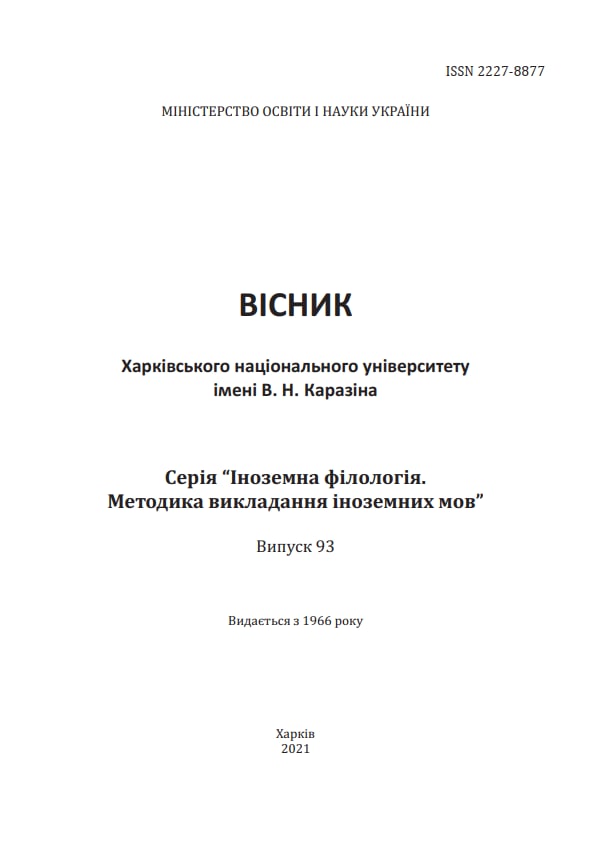Rendering means of multimodal representation of celebrities in American comedy animated sitcoms in translation
Abstract
This article presents the results of comparative analysis of the strategies of rendering mono- and multimodal parodic representations of celebrities from the American comedy animated sitcom “BoJack Horseman” in English-Ukrainian and English-Russian translations. The study had revealed monomodal parodic representations of celebrity characters realized verbally by using the name in a dialogue and multimodal parodic representations, both literal and based on pun, that are realized by the interaction of the name, image and sound. The study has found that monomodal parodic representations constitute a translation problem due to their allusive potential, reproduction of which in the case of cultural / subcultural specificity of allusion is solved by domestication. Translation of literal multimodal representations constructed by real celebrity names and close-to-real images is performed by transcoding. Translation of visual puns causes no difficulties since in their case incongruity is created by the images. Translation of verbal-visual puns that are constructed via interaction of a pun name and a metaphoric anthropomorphic image is not problematic only if the name is easily recognizable and the target language has resources to retain the pun. The study has revealed that to render such puns Ukrainian translators mostly resort to domestication by means of substitution. Russian translators employ foreignization by means of transcoding that leads to the loss of the correlation between the text and image and the loss of the humorous effect. Transcoding is relevant only if the name of a celebrity is generally known and correlates with the image. If the name is culturally or subculturally specific, transcoding leads to foreignization of the target text. The study has found that domestication strategy is more communicatively relevant for reproducing multimodal puns since it allows correlation of the word and image and reproduces the humorous effect.
Downloads
References
BoJack Horseman. Bojack.nf-fan.tv. Retrieved from https://bojack.nf-fan.tv/.
BoJack Horseman. Ling.online. Retrieved from https://ling.online/ru/videos/serials/bojack-horseman/.
Definitions. Dictionary.com. Retrieved from https://www.dictionary.com/.
Kin` BoDzhek ukrayins`koyu movoyu onlajn [BoJack Horseman in Ukrainian online]. Simpsonsua.tv. Retrieved from: https://simpsonsua.tv/bojack/. (in Ukrainian)
Koestler, A. (1964). The act of creation. New York, NY: The Macmillan Company.
Kon' BoDzhek [BoJack Horseman]. Lordfilmhd.cc. Retrieved from //lordfilmhd.cc/918-kon-bodzhek.html. (in Russian)
Kress, G. (2010). Multimodality: A ocial-semiotic approach to contemporary communication. London: Routledge.
Luk'yanova, T. G. (2018). Verbalizaciya emocijny`x staniv v mul`ty`modal`nomu teksti: intersemioty`chny`j pereklad (na materiali anglijs`koyi ta ukrayins`koyi mov) [Verbalization of emotional states in multimodal text: intersemiotic translation (based on the material of the English and Ukrainian languages)]. Visny`k XNU imeni V.N. Karazina. Seriya: Inozemna filologiya. Metody`ka vy`kladannya inozemny`x mov [The Journal of V. N. Karazin Kharkiv National University. Series: Foreign Philology. Methods of Foreign Language Teaching], 88, 105–111. (in Ukrainian)
Martynyuk, A. (2017). The art of metaphoric political insult within the cognitive framework. Language – literature – the arts: A cognitive-semiotic Interface. Text – meaning – context, 14, 245–260). https://doi.org/10.3726/b10692.
McGhee, P. E. (1972). On the cognitive origins of incongruity humour: fantasy assimilation versus reality assimilation. In J. H. Goldstein, P. E. McGhee (Eds.), The psychology of humour. (pp. 61–80). London-New York, NY: Academic Press.
O’Sullivan C. (2013). Introduction: Multimodality as challenge and resource for translation. The Journal of Specialised Translation, 20, 2–14.
Raskin, V. (1985) Semantic mechanisms of humour. Dordrecht-Boston-Lancaster: D. Reidel.
Sannikov, V. Z. (2002) Russkij jazyk v zerkale jazykovoj igry [Russian Language in the Mirror of the Language Game]. Moskva: Jazyki slavjanskoj kul'tury. (in Russian)




